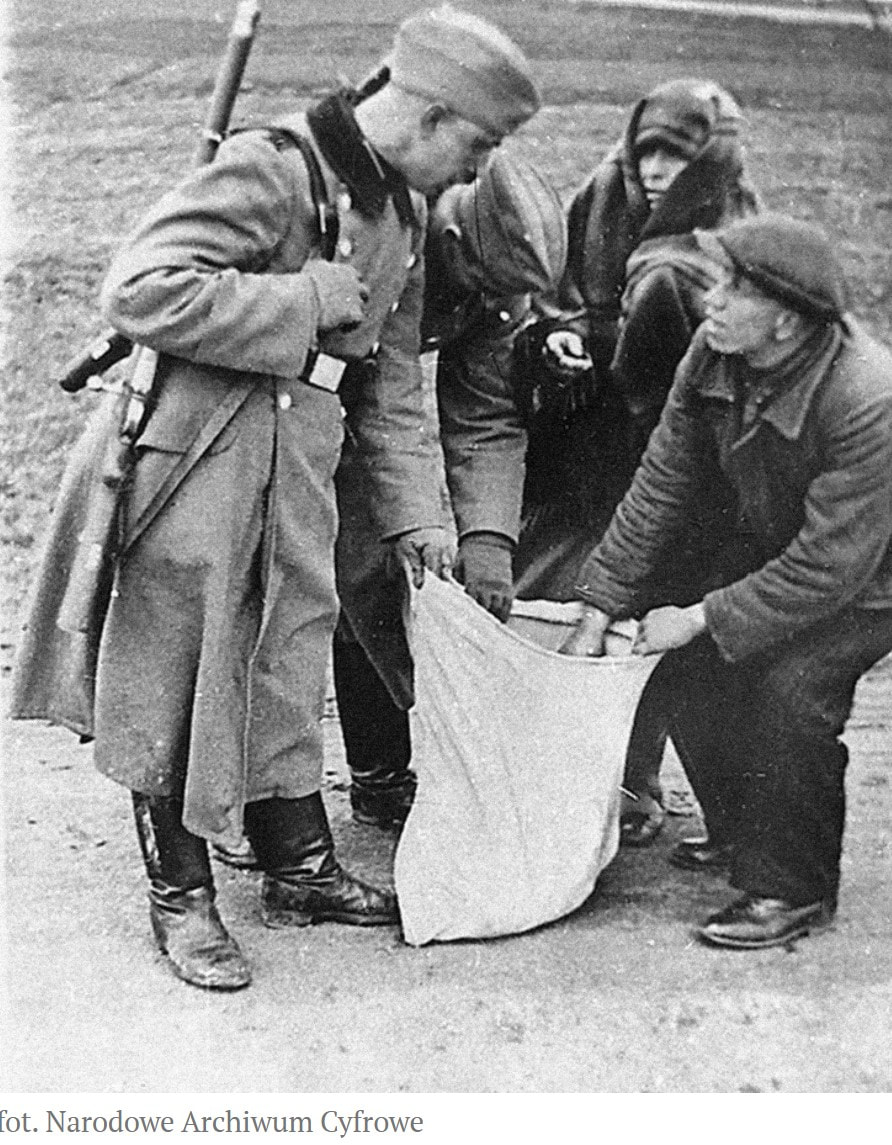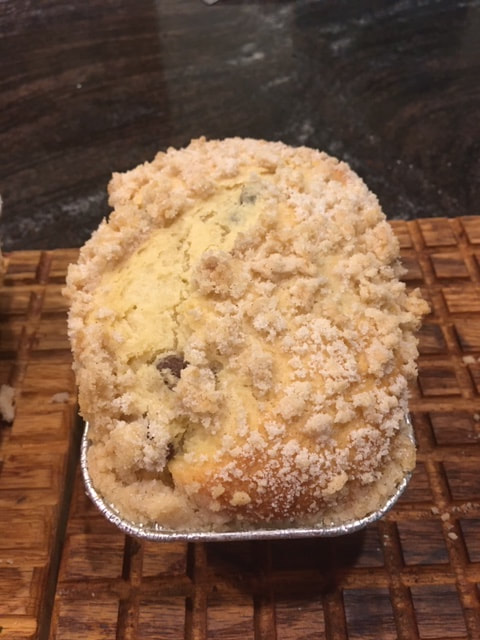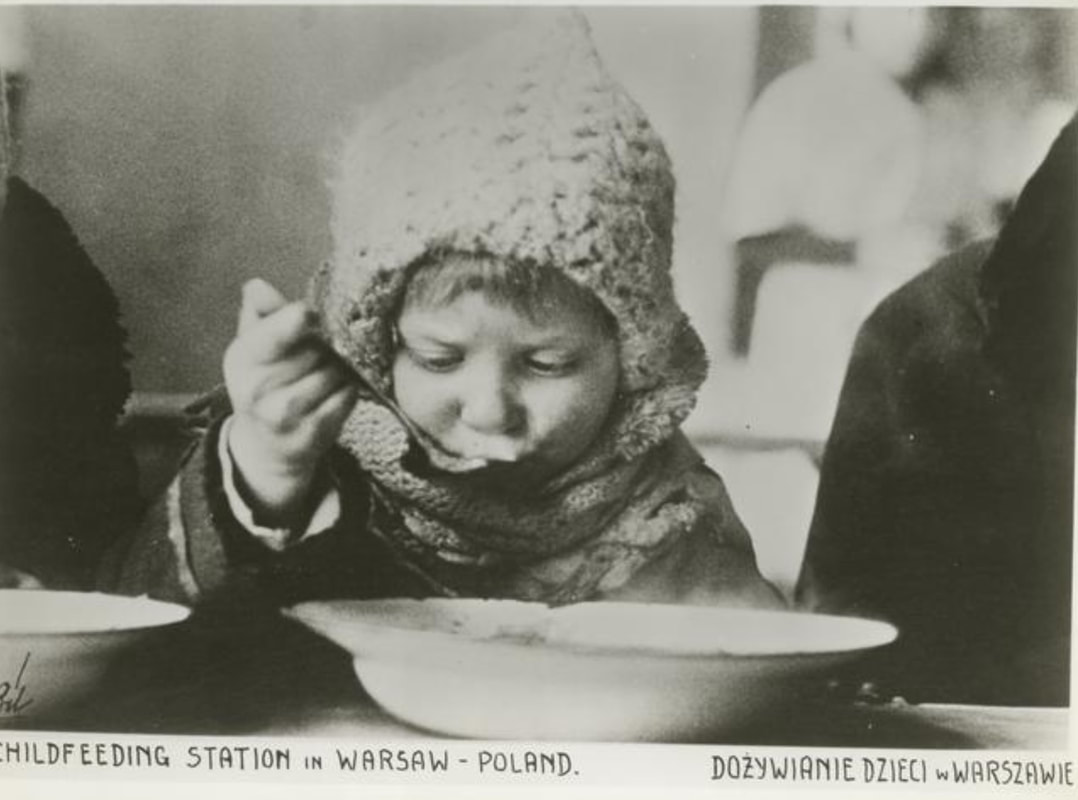|
To Polish Americans, the term placek conjures up the image of a sweet yeast bread with a crumbly topping of flour, butter and sugar baked in a rectangular loaf pan. Polish ethnographers studying the preparation of food and its consumption among the country folk feel that placek, the name given to a cake made of yeast that was baked for special occassions, is the modern evolution of the ancient kołacz, the special bread baked for weddings. Ethnographer Jan Bystron states, "in certain parts of Poland the kołacz is called placek. This is a baked item made from white wheat flour with cheese and raisins."
In light of the requests I received for the recipe after I posted this photo of the placek I made for St. Casimir's Church (Buffalo, NY) Our Lady's Street Fair, I'm posting it here for those of you who asked (thank you for the compliment!) and for anyone who may be interested. Placek 3 eggs 4 cups plus 4 tablespoons unbleached flour ½ cup golden yellow or dark raisins ½ cup hot water Two ¼ ounce packages active dry yeast ½ cup warm water 1 cup sugar 1 cup milk ½ cup butter (one stick) 1 teaspoon salt ¼ teaspoon nutmeg 1 teaspoon vanilla Topping ⅓ cup sugar 3 tablespoons flour 2 tablespoons butter ⅛ teaspoon nutmeg ⅛ teaspoon cinnamon 1.Bring eggs and flour to room temperature. 2.Soak raisins in the hot water for 30 minutes or until plump. Drain and squeeze raisins lightly to remove excess fluid. 3.Place ½ cup warm water (110º to 115ºF) into a 2 cup measuring glass or bowl. Sprinkle yeast over the water and mix. Add ½ teaspoon of the sugar to the yeast mixture and 4 tablespoons of the flour to make a tin batter. Set aside or 15 to 20 minutes. It should become bubbly and frothy. 4.Scald the milk in a saucepan, remove from heat and add the butter, salt nutmeg and vanilla. Cool to lukewarm (110º to 115ºF.) 5. In a large mixing bowl, beat the eggs and remaining sugar until pale yellow. Add the lukewarm milk mixture and then the yeast mixture. 6.Gradually add the remaining 4 cups of flour, beating well. Add the raisins and mix thoroughly. The dough will be somewhat sticky. 7.Place in a warm area and allow dough to double in bulk about an hour(or sometimes more) 8.Grease and lightly flour 2 9x5 inch or 8x3½ inch loaf pans. Distribute the dough evenly between the pans. Cover and let rise again for 30 minutes. 9.While dough is rising, make the topping. Place dry ingredients in small bowl and cut the butter into the flour, sugar, nutmeg and cinnamon until it looks like coarse meal, as if making a pie crust. Or, place ingredients in food processor and pulse together for same effect. 10.Preheat oven to 350ºF. Sprinkle topping evenly over the dough and bake for 30 minutes. Smacznego! May it be tasty! Recipe from Polish Country Kitchen Cookbook by Sophie Hodorowicz Knab. Hippocrene Books, Inc.
4 Comments
On this day, August 24th, 1942 during the occupation of Poland by the Germans, Hans Frank, governor of the General Government, decided to starve the Polish people in order to provide more food for German troops and the German people. In a Cabinet session with his departmental chiefs in Kraków he ordered the stoppage of food rations for all Poles who were not working for German interests. Hans Frank: “Before the German people are to experience starvation, the occupied territories and their people shall be exposed to starvation...The general Government has taken on the obligation to send 500,000 tons of bread grains to the fatherland….it must be done cold-bloodedly and without pity…you will essentially find an additional increase of the quota of foodstuffs to be shipped to Germany and new regulations for the feeding of the Jews and of the Polish population.” (1) All food was seized for German consumption. Farmers in the Polish countryside were subject to compulsory quotas and levies developed by the Germans, resulting in the ruthless confiscation of wheat, cattle, eggs, honey, and poultry from farms throughout the General Government which left millions of Poles facing starvation. The absence of milk subjected an entire generation of Polish children to suffer from vitamin and protein deficiency. Consumers were divided into broad categories in which each received rations in proportion to alleged needs and importance. All-important food groups were rationed at weekly or monthly amounts. Bread rations were cut drastically. More from Hans Frank’s diary: "…more than 3 million persons are non-German normal consumers (Poles), who do not work directly or indirectly in the interests of Germany"...and that these "non-German normal consumers will receive, from 1 January 1943 to 1 March 1943, instead of 4.2 kg of bread per month, 2.8 kg; from 1 March 1943 to 30 July 1943 the total bread ration for the non-German normal consumers will be cancelled." (2) According to German regulations, each resident had to be satisfied with the amount of food he was entitled to according to the allocation set in the card system. The trouble was, they were starvation rations. Critical shortages of food arose in urban areas with people resorting to every possible means to find food. To try and fill the void, black markets sprung up, but being caught in any activity with black markets was punishable with a fine, months in a penal camp, or their life.  Photo: German soldiers during an inspection in search of illegal food. Jadwiga Załuska, a nurse in occupied Warsaw, recalls: "The food situation was getting worse all the time but being rescued by people bringing food to Warsaw illegally...Everyone in Warsaw had some kind of haunt where on a designated day they could obtain some dairy product and meat ...The business was generally conducted by women and their ingenuity was something. They brought in (from the outlying farms) sausage under their clothes, winding pork fat around their waist. The most difficult to bring in was eggs and cream...There were so many women raising their children alone that they would walk kilometers carrying potatoes or eggs, the entire time faced with the possibility of confiscation and a beating...the obtaining of smuggled goods was an impossibility - people didn't have the money and the majority were starving on food coupons. People were making up all kinds of dishes to quiet their stomachs. Sausage was being made from cabbage, pancakes from beans, spice cookies and cakes from carrots...and pumpkin."(3) The situation for the people of Poland was critical. The few Polish-run charitable organizations allowed by the Germans were overwhelmed. The years 1942 and 1943 brought the greatest reduction in food available to the people of the General Government. Consistently malnourished, the people of Poland became easy prey to a host of diseases including tuberculosis, gastrointestinal and disorders, and communicable diseases. The people of Poland were doomed to suffer and starve right through to the end of the war. 1.Frank diary. Document PS-E-2233 Cabinet session 2 4August 1942 Nazi Conspiracy and Aggression. Volume 4 2.Ibid 3.Chapter 5 . Wearing the Letter”P”. Polish Women as Forced Laborers in Nazi Germany 1939-1945 Photo credits: Child Feeding Station: New York Public Library: Poland in Photographs 1939-1944 Germans inspecting for illegal food: Narodowy Archiwum Cyfrowe |
Categories
All
One of the biggest moments in my life was being able to sign for my very own library card. When I'm not reading, researching and writing I'm riding my bike, sewing or gardening. I love flea markets, folk art, and traveling to Poland.
Archives
July 2024
|


 RSS Feed
RSS Feed